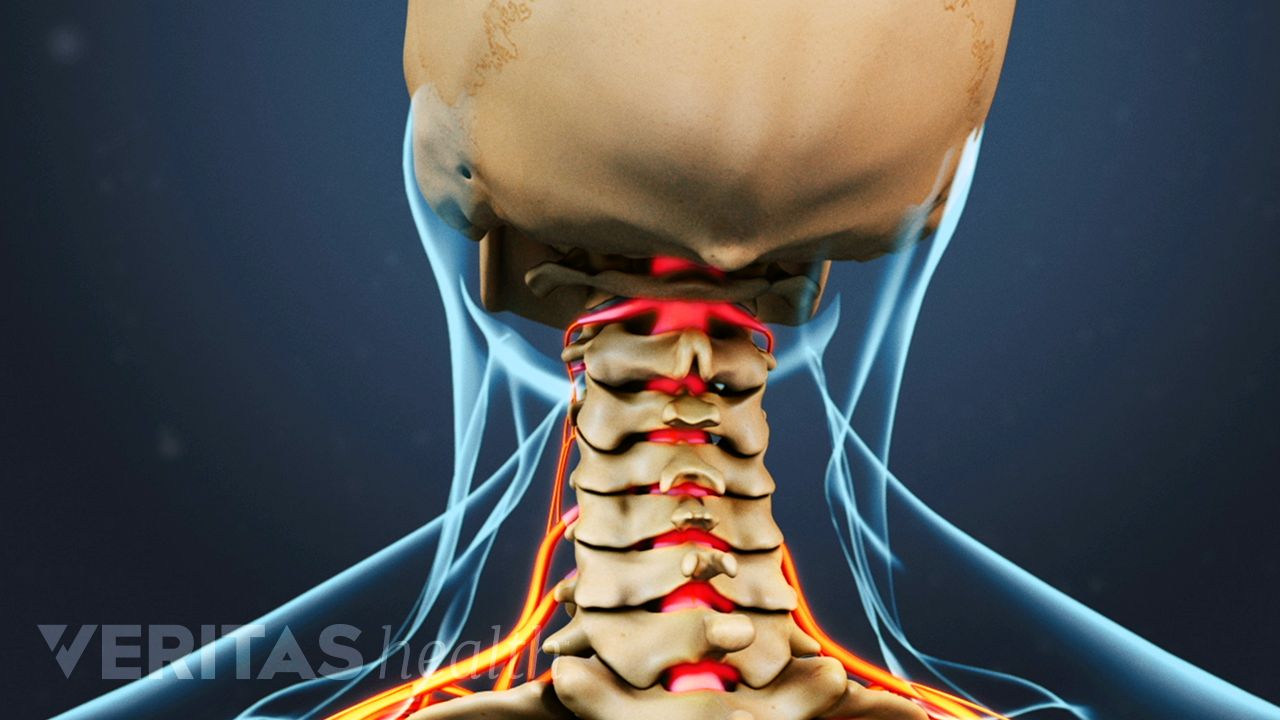Neck Pain Causes
The most common causes of neck pain—strains and sprains—heal within a few days or weeks. A strain is when a muscle or tendon has been irritated by overuse or overextension. Similarly, a sprain is when a ligament has been irritated by overuse or overextension.
Common causes of neck strains and sprains include:
-
- Sleeping in wrong position. Often referred to as a “crick” in the neck, a person might wake up in the morning with neck pain due to sleeping in an awkward or atypical position that overextended the neck.
- Sports injury. A person could move the neck suddenly and/or in an unusual way in a new sport, or a player could have a collision or fall. A common sports collision injury is a stinger, which happens when nerves in the neck/shoulder are impacted and pain, numbness, and weakness can radiate down the shoulder, arm, and hand.
-
- Poor posture. Whether it’s at work, home, and/or commuting, poor posture can lead to neck problems. If a person’s head is often tilted forward for long periods of time, then the neck’s muscles, tendons, and ligaments need to work harder. Poor posture can be problematic during any number of activities, including working at a computer, watching TV, riding the train, reading a book, gardening, and more. Text neck, for example, is an increasingly common problem that develops in anyone who spends hours looking down at the phone while texting.
-
- Repetitive motions. Turning the head in a repetitive manner, such as side to side while dancing or swimming, may lead to overuse of the neck’s muscles, tendons, and ligaments.
- Holding the head in unusual position. Anything that requires holding the head in an unusual way for long periods of time could cause neck strains and sprains. Some examples include having a long conversation while cradling a phone between the head and shoulder, or spending an afternoon looking up at an air show.
- Whiplash. In a whiplash injury, the head and neck are forced suddenly backward and immediately forward with a great deal of force. The soft tissues along and near the cervical spine can be torn or ruptured as a result. This type of injury commonly occurs in an auto accident that involves a rear-end collision.
Causes of Chronic Neck Pain
Neck pain is considered chronic when it persists for more than 3 months. These conditions tend to stem from problems in the cervical spine either with a facet joint or disc. Common causes include:
- Cervical degenerative disc disease.
Everyone experiences wear and tear on the cervical spine over time. It’s natural for the discs to gradually lose hydration and the ability to cushion the spine’s vertebrae. If a disc degenerates enough, it can lead to painful irritation of a cervical nerve in various ways, such as a herniated disc, pinched nerve, or changes in the facet joints that can cause arthritis.- Cervical herniated disc A cervical disc is herniated when its jelly-like inner layer, the nucleus pulposus, leaks out through a tear in the disc’s protective outer layer. This could result from an injury or aging. A herniated disc may press against or pinch a cervical nerve, or the inflammatory proteins of the nucleus pulposus may come close enough to a nerve to cause irritation.
- Cervical osteoarthritis
When the cartilage in a cervical facet joint wears down enough, it can lead to cervical osteoarthritis, also known as cervical spondylosis. Rather than having the facet joints move smoothly along cartilage as intended, they might grind bone on bone. The joint could become enlarged from inflammation and bone spur growth, causing a nearby nerve to become pinched or pressed- Cervical spinal stenosis with myelopathy Spinal stenosis occurs when the spine’s degeneration leads to a narrowing of the spinal canal, such as from a herniated disc that pushes into the spinal canal or bone spurs that grow into the canal. When the spinal canal narrows enough to compress the spinal cord—a large bundle of nerves that runs inside the spinal canal—myelopathy can result. Myelopathy is when compression of the spinal cord starts causing symptoms, such as weakness or problems with coordination in the arms, hands, legs, or feet.
- Cervical foraminal stenosis This condition occurs when the foramina—the holes in the vertebral construct through which nerve roots that branch off from the spinal cord can exit the spinal canal—become narrowed. This narrowing of the hole can cause irritation for the nerve root that runs through it. Foraminal stenosis is associated with radiating pains in a pattern specific to the nerve that is pinched by the narrowing. In some situations, there is a combination of the cervical stenosis causing myelopathy, as well as the specific nerve pattern associated with a cervical foramen being narrowed.
Other Causes of Neck Pain
While not the most common causes of acute or chronic neck pain, other causes of neck pain could include:
-
- Emotional stress. Sometimes muscles in the neck can tighten up and ache in response to stress, anxiety, or depression.
- Infection. If part of the cervical spine becomes infected, then inflammation could cause neck pain. One example would be meningitis.
-
- Myofascial pain. This chronic condition has trigger points, which result from achy muscles and surrounding connective tissues, typically in the upper back or neck. Trigger points can be chronically painful or only painful to the touch. The pain might stay in one spot or it can be referred pain that spreads to/from another area in the body.
- Fibromyalgia. Fibromyalgia is hard to diagnose, but it typically involves pain in the muscles, tendons, and ligaments in several areas of the body, including in the neck.
-
- Spinal tumor. A tumor, such as from cancer, could develop in the cervical spine and press against a nerve. These types of tumors more commonly occur as cancer that has started in another part of the body metastasizes.
-
- Spondylolisthesis. This condition occurs when one vertebra slips over the one below it. It can be due to a tiny fracture in the vertebra, or possibly from advanced disc degeneration, or ligament laxity.
-
- Ankylosing spondylitis. This progressive arthritis of the spine and pelvis can cause widespread inflammation, pain and stiffness throughout the spine, including the neck.
Risk Factors for Developing Neck Pain
Some research indicates that getting unhealthy amounts of sleep, being inactive, and smoking can all raise the risk of developing neck pain.2 In addition, working longer hours or being in a labor-intensive occupation, such as the military, health care support, or installation and maintenance, may increase the risk for neck pain.3
References
- Croft PR, Lewis M, Papageorgiou AC, et al. Risk factors for neck pain: a longitudinal study in the general population. Pain. 2001; 93(3):317-25.
- Yang, Haiou PhD; Haldeman, Scott DC, MD, PhD; Nakata, Akinori PhD; Choi, BongKyoo ScD, MPH; Delp, Linda PhD, MPH; Baker, Dean MD, MPH. Work-related risk factors for neck pain in the US working population. Spine. 2015. 40(3):184-192.

